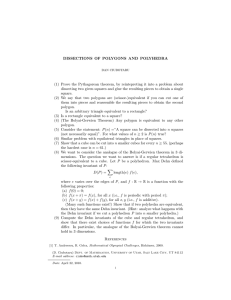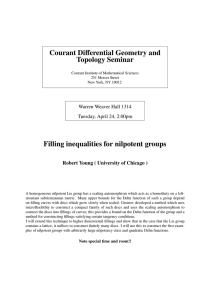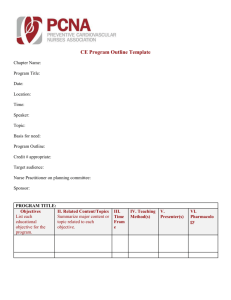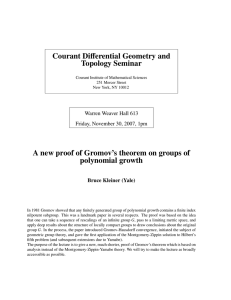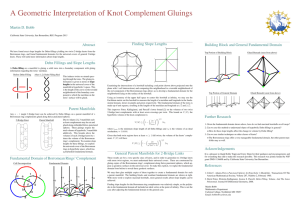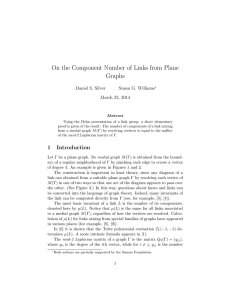Quantifying simple connectivity: an introduction to the Dehn function Robert Young
advertisement
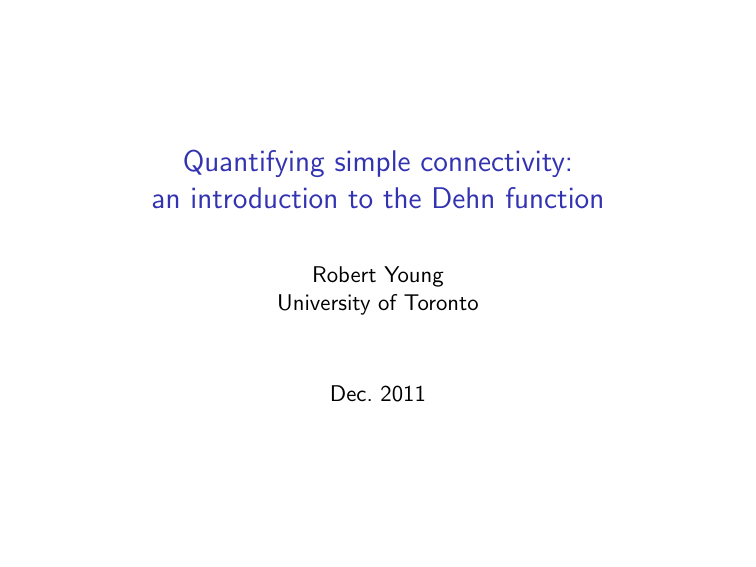
Quantifying simple connectivity: an introduction to the Dehn function Robert Young University of Toronto Dec. 2011 What is quantitative geometry? One answer: Making existence problems quantitative. What is quantitative geometry? One answer: Making existence problems quantitative. I A closed manifold has closed geodesics. (Lusternik-Fet) Q: What’s the length of the shortest closed geodesic? What is quantitative geometry? One answer: Making existence problems quantitative. I A closed manifold has closed geodesics. (Lusternik-Fet) Q: What’s the length of the shortest closed geodesic? A: Gromov’s systolic inequality What is quantitative geometry? One answer: Making existence problems quantitative. I I A closed manifold has closed geodesics. (Lusternik-Fet) Q: What’s the length of the shortest closed geodesic? A: Gromov’s systolic inequality A map f : X → Y is homotopic to a cellular map f¯. Q: How big is f¯(X )? What is quantitative geometry? One answer: Making existence problems quantitative. I I A closed manifold has closed geodesics. (Lusternik-Fet) Q: What’s the length of the shortest closed geodesic? A: Gromov’s systolic inequality A map f : X → Y is homotopic to a cellular map f¯. Q: How big is f¯(X )? A: The Federer-Fleming deformation theorem What is quantitative geometry? One answer: Making existence problems quantitative. I I I A closed manifold has closed geodesics. (Lusternik-Fet) Q: What’s the length of the shortest closed geodesic? A: Gromov’s systolic inequality A map f : X → Y is homotopic to a cellular map f¯. Q: How big is f¯(X )? A: The Federer-Fleming deformation theorem A compact metric space can be covered by finitely many metric balls. Q: How many? What is quantitative geometry? One answer: Making existence problems quantitative. I I I A closed manifold has closed geodesics. (Lusternik-Fet) Q: What’s the length of the shortest closed geodesic? A: Gromov’s systolic inequality A map f : X → Y is homotopic to a cellular map f¯. Q: How big is f¯(X )? A: The Federer-Fleming deformation theorem A compact metric space can be covered by finitely many metric balls. Q: How many? A: Hausdorff measure and Hausdorff dimension What is quantitative geometry? One answer: Making existence problems quantitative. I I A closed manifold has closed geodesics. (Lusternik-Fet) Q: What’s the length of the shortest closed geodesic? A: Gromov’s systolic inequality A map f : X → Y is homotopic to a cellular map f¯. Q: How big is f¯(X )? A: The Federer-Fleming deformation theorem I A compact metric space can be covered by finitely many metric balls. Q: How many? A: Hausdorff measure and Hausdorff dimension I If X is simply connected, then every curve in X bounds a disc. Q: How big is the filling? What is quantitative geometry? One answer: Making existence problems quantitative. I I A closed manifold has closed geodesics. (Lusternik-Fet) Q: What’s the length of the shortest closed geodesic? A: Gromov’s systolic inequality A map f : X → Y is homotopic to a cellular map f¯. Q: How big is f¯(X )? A: The Federer-Fleming deformation theorem I A compact metric space can be covered by finitely many metric balls. Q: How many? A: Hausdorff measure and Hausdorff dimension I If X is simply connected, then every curve in X bounds a disc. Q: How big is the filling? A: The Dehn function Measuring simple connectivity: The Dehn function Let X be a simply-connected simplicial complex or manifold and let α : S 1 → X be a closed curve. Define δ(α) = inf β:D 2 →X β|S 1 =α area β. Measuring simple connectivity: The Dehn function Let X be a simply-connected simplicial complex or manifold and let α : S 1 → X be a closed curve. Define δ(α) = inf β:D 2 →X β|S 1 =α δX (n) = area β. sup δ(α). α:S 1 →X `(α)≤n Measuring simple connectivity: The Dehn function Let X be a simply-connected simplicial complex or manifold and let α : S 1 → X be a closed curve. Define δ(α) = inf β:D 2 →X β|S 1 =α δX (n) = area β. sup δ(α). α:S 1 →X `(α)≤n In the case of R2 , the circle has maximal area for a given perimeter, so δR2 (2πr ) = πr 2 . The word problem: how do you recognize the identity? Let G = hg1 , . . . , gn | r1 , . . . , rm i. The word problem: how do you recognize the identity? Let G = hg1 , . . . , gn | r1 , . . . , rm i. The word problem: If w is a product of generators (a word), how can we tell if it represents the identity? Reducing using relations Any two words representing the same group element can be transformed into each other by: I Application of a relation: wri±1 w 0 ↔ ww 0 I Free insertion/reduction: wgi±1 gi∓1 w 0 ↔ ww 0 Reducing using relations Any two words representing the same group element can be transformed into each other by: I Application of a relation: wri±1 w 0 ↔ ww 0 I Free insertion/reduction: wgi±1 gi∓1 w 0 ↔ ww 0 Q: How many steps does this take? The Dehn function of a group If w represents the identity, define δ(w ) = # of applications of relations to reduce w and δG (n) = max δ(w ). `(w )≤n w =G 1 Example: Z2 Let Z2 = hx, y | [x, y ]i. Going from xy to yx takes one application of the relation: xy → (yxy −1 x −1 )xy → yx. So if w = x 2 y 2 x −2 y −2 , then w represents the identity and δ(w ) = 4. Similarly, δ(x n y n x −n y −n ) = n2 . Example: Z2 Let Z2 = hx, y | [x, y ]i. Going from xy to yx takes one application of the relation: xy → (yxy −1 x −1 )xy → yx. So if w = x 2 y 2 x −2 y −2 , then w represents the identity and δ(w ) = 4. Similarly, δ(x n y n x −n y −n ) = n2 . This implies that δZ2 (4n) ≥ n2 ; in fact, δZ2 (4n) = n2 . Example: Z2 Let Z2 = hx, y | [x, y ]i. Going from xy to yx takes one application of the relation: xy → (yxy −1 x −1 )xy → yx. So if w = x 2 y 2 x −2 y −2 , then w represents the identity and δ(w ) = 4. Similarly, δ(x n y n x −n y −n ) = n2 . This implies that δZ2 (4n) ≥ n2 ; in fact, δZ2 (4n) = n2 . Theorem (Gromov) When G acts geometrically (properly discontinuously, cocompactly, by isometries) on a space X , the Dehn function of G and of X are the same up to constants. Fundamental groups of surfaces d c b c d a b a c d b a Fundamental groups of surfaces d c b c d a b a c d b a G = ha, b, c, d | aba−1 b −1 cdc −1 d −1 i Dehn’s algorithm for the word problem Let w be a word. 1. Look for a subword that consists of more than half of the octagon w = . . . dc −1 −1 d c d ab . . . b a c d b a Dehn’s algorithm for the word problem Let w be a word. 1. Look for a subword that consists of more than half of the octagon w = . . . dc −1 −1 d c d ab . . . 2. Apply a relation to shorten it. w = . . . c −1 ba . . . b a c d b a Dehn’s algorithm for the word problem Let w be a word. 1. Look for a subword that consists of more than half of the octagon w = . . . dc −1 −1 d c d ab . . . 2. Apply a relation to shorten it. w = . . . c −1 ba . . . b a c d b a Dehn’s algorithm for the word problem Let w be a word. 1. Look for a subword that consists of more than half of the octagon w = . . . dc −1 −1 d ab . . . 2. Apply a relation to shorten it. w = . . . c −1 ba . . . 3. Repeat. c d b a c d b a Dehn’s algorithm for the word problem Let w be a word. 1. Look for a subword that consists of more than half of the octagon w = . . . dc −1 −1 d c d ab . . . 2. Apply a relation to shorten it. w = . . . c −1 ba . . . b a c d b a 3. Repeat. If this reduces w to the trivial word, it represents the identity; otherwise, it doesn’t. The universal cover is the hyperbolic plane c b d c a d b a Any closed path of edges (and thus any word that represents the identity) must contain most of an octagon. Linear Dehn functions correspond to negative curvature Theorem (Gromov, Lysenok, Cannon) If G is a finitely presented group, the following are equivalent: I Dehn’s algorithm solves the word problem I G is word-hyperbolic (i.e., triangles in the Cayley graph are thin) Linear Dehn functions correspond to negative curvature Theorem (Gromov, Lysenok, Cannon) If G is a finitely presented group, the following are equivalent: I Dehn’s algorithm solves the word problem I G is word-hyperbolic (i.e., triangles in the Cayley graph are thin) Theorem (Gromov) If G is a finitely presented group, the following are equivalent: I G is word-hyperbolic I δG (n) ∼ n Linear Dehn functions correspond to negative curvature Theorem (Gromov, Lysenok, Cannon) If G is a finitely presented group, the following are equivalent: I Dehn’s algorithm solves the word problem I G is word-hyperbolic (i.e., triangles in the Cayley graph are thin) Theorem (Gromov) If G is a finitely presented group, the following are equivalent: I G is word-hyperbolic I δG (n) ∼ n I δG (n) n2 Linear Dehn functions correspond to negative curvature Theorem (Gromov, Lysenok, Cannon) If G is a finitely presented group, the following are equivalent: I Dehn’s algorithm solves the word problem I G is word-hyperbolic (i.e., triangles in the Cayley graph are thin) Theorem (Gromov) If G is a finitely presented group, the following are equivalent: I G is word-hyperbolic I δG (n) ∼ n I δG (n) n2 I Geodesics diverge exponentially Linear Dehn functions correspond to negative curvature Theorem (Gromov, Lysenok, Cannon) If G is a finitely presented group, the following are equivalent: I Dehn’s algorithm solves the word problem I G is word-hyperbolic (i.e., triangles in the Cayley graph are thin) Theorem (Gromov) If G is a finitely presented group, the following are equivalent: I G is word-hyperbolic I δG (n) ∼ n I δG (n) n2 I Geodesics diverge exponentially I Several other definitions Examples I Any negatively curved space has Dehn function bounded by n. I Any non-positively curved space has Dehn function bounded by n2 . Examples I Any negatively curved space has Dehn function bounded by n. I Any non-positively curved space has Dehn function bounded by n2 . I For any integer c ≥ 2, there’s a nilpotent group with Dehn function growing like nc . Examples I Any negatively curved space has Dehn function bounded by n. I Any non-positively curved space has Dehn function bounded by n2 . I For any integer c ≥ 2, there’s a nilpotent group with Dehn function growing like nc . I The Baumslag-Solitar group ha, b | a−1 ba = b 2 i has exponential Dehn function. Examples I Any negatively curved space has Dehn function bounded by n. I Any non-positively curved space has Dehn function bounded by n2 . I For any integer c ≥ 2, there’s a nilpotent group with Dehn function growing like nc . I The Baumslag-Solitar group ha, b | a−1 ba = b 2 i has exponential Dehn function. I There are groups with two generators and one relation which have Dehn function larger than any tower of exponentials. Examples I Any negatively curved space has Dehn function bounded by n. I Any non-positively curved space has Dehn function bounded by n2 . I For any integer c ≥ 2, there’s a nilpotent group with Dehn function growing like nc . I The Baumslag-Solitar group ha, b | a−1 ba = b 2 i has exponential Dehn function. I There are groups with two generators and one relation which have Dehn function larger than any tower of exponentials. I If G has unsolvable word problem, then δG is larger than any computable function. t e Sol3 = 0 0 0 e −t 0 has exponential Dehn function. x y x, y , t ∈ R 1 t e Sol3 = 0 0 0 e −t 0 x y x, y , t ∈ R 1 has exponential Dehn function. a b 0 x a e e x e y Sol3 ⊂ 0 e b y ∼ × = Hyp2 ×Hyp2 = 0 1 0 1 0 0 1 t e1 0 Sol5 = 0 0 0 e t2 0 0 has quadratic Dehn function. a e 0 0 b 0 e 0 Sol5 ⊂ 0 0 ec 0 0 0 0 0 e t3 0 x X y t = 0 i z 1 x y = Hyp2 × Hyp2 × Hyp2 z 1 t e1 0 Sol5 = 0 0 0 e t2 0 0 has quadratic Dehn function. a e 0 0 b 0 e 0 Sol5 ⊂ 0 0 ec 0 0 0 0 0 e t3 0 x X y t = 0 i z 1 x y = Hyp2 × Hyp2 × Hyp2 z 1 But has spheres which are exponentially difficult to fill! Open questions I Similar geometry shows up in semisimple groups. (e.g., Druţu, Bux-Wortman, Y.) What can you say about them? Open questions I Similar geometry shows up in semisimple groups. (e.g., Druţu, Bux-Wortman, Y.) What can you say about them? I Filling spheres and cycles rather than curves? Open questions I Similar geometry shows up in semisimple groups. (e.g., Druţu, Bux-Wortman, Y.) What can you say about them? I Filling spheres and cycles rather than curves? I Other groups?
